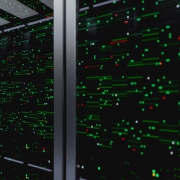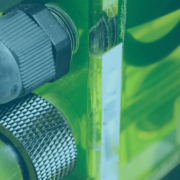Startups brew new chemistries for fresh battery types
Through their public commitments to net-zero carbon emission targets, cloud providers have re-energized talks of a major redesign of critical power systems within the data center sector. The elimination of diesel fuel use is chief among the goals, but the desire for a leaner facility power infrastructure that closely tracks IT capacity needs is also attracting interest. New types of batteries, among other tools such as clean fuels, will likely prove instrumental in this endeavor.
Operators have already started displacing standard valve-regulated lead-acid (VRLA) banks with lithium-ion (Li-ion) batteries to refashion data center backup power. According to the upcoming 2021 Uptime Institute Global Data Center Survey report, nearly half of operators have adopted the technology for their centralized uninterruptible power supply (UPS) plant, up from about a quarter three years ago. Compared with VRLA, Li-ion batteries are smaller, easier to monitor and maintain, and require less stringent climatic controls. (See our post: Lithium-ion batteries for the data center: Are they ready for production yet? for more technical details.)
In addition, Li-ion batteries have a much longer service life, which offsets most of the higher initial cost of Li-ion packs. The change in chemistry also makes possible use cases that were not previously feasible with VRLA — for example, demand-response schemes in which operators can use their Li-ion UPS systems for peak load shaving when there is a price incentive from the electric utility.
But these advantages are not without significant trade-offs. According to recent research by the US-based National Fire Protection Association, Li-ion batteries (regardless of their specific chemistries and construction) represent a higher fire risk than VRLA. Worse still, Li-ion fires are notoriously difficult to suppress, as the breakdown of cells produces combustible gases — a situation that creates the conditions for life-threatening explosions. Even though some chemistries, such as lithium iron phosphate, have a comparatively lower risk of fire (due to a higher ignition point and no release of oxygen), the possibility of thermal runaway persists.
Then there is the matter of sustainability. VRLA batteries are effectively fully recycled to produce new batteries, at no cost to the owner (owing to lead toxicity-related regulation). That is not the case for large Li-ion battery packs, where the industrial base for recycling has yet to develop — most Li-ion-powered products haven’t reached their end of life. Repackaging and repurposing for less demanding applications seem a more likely solution than breaking down to materials but is still challenging. Furthermore, supply chains for Li-ion production, along with their social and environmental impacts, stay obscure to buyers.
These issues have already given some data center operators and their contractors pause. But they have also created an opening in the market to other branches of battery chemistry. One promising family for high-power applications relies on sodium (Na) ions instead of lithium as its main component to carry the charge, while developments in iron-air (FeO2) batteries raise hopes of building economical and safe energy storage for very long backup times.
Na-ion cells pose no thermal runaway risk and offer much higher power-to-capacity ratios. Even better, they can repeatedly discharge their full energy at very high rates, in one to two minutes, then fully recharge in 10 to 20 minutes without overheating. Durability is also better than that of Li-ion cells.
However, a significant disadvantage is the size of Na-ion batteries compared to state-of-the-art Li-ion (although they are still more compact than VRLA). These features make Na-ion batteries interesting for UPS applications with shorter runtime targets (e.g., up to 10 minutes). More importantly, perhaps, Na-ion seems safe for installation in data halls, where operators can use it in distributed UPS topologies that closely match power service level to IT capacity requirements. Social and environmental impacts from sodium battery manufacturing also appear less concerning, as they tend to use no rare earth elements or minerals tainted by the conditions of extraction (although practical recyclability is an outstanding question).
Multiple startups have already attracted funding to commercialize sodium batteries for various use cases, both stationary and mobile (including industrial vehicles). Examples are Natron Energy (US), Faradion (UK), and CATL (China). The fabrication process of Na-ion battery shares many commonalities with Li-ion, making its industrialization relatively straightforward — producers can tap into a large pool of toolmakers and manufacturing know-how. All the same, it will take another few years (and hundreds of millions of dollars) for Na-ion battery production to ramp up.
Meanwhile, US startup Form Energy has recently raised $200 million (bringing total life-to-date funding past $325 million) to commercialize an entirely different type of battery that aims to solve not the power but the energy capacity problem. The company says it has figured out how to make effective iron-air (FeO2) batteries that can store energy for long periods and discharge it slowly over many hours (the design target is 100 hours) when needed. Because of the inexpensive ingredients, Form claims that FeO2 cells cost a small fraction (15%) of Li-ion per kilowatt-hour.
Form Energy is now targeting 2025 for the first battery deployments. There seems to be a catch, however: space. According to the firm, a Form Energy system that can hold a 3-megawatt load for four days occupies an acre of land. Even if this can be reduced by lowering runtime to, say, 24 hours, it will still require several times the footprint of a diesel generator set and associated fuel storage. Nonetheless, if product development goes to plan, Form Energy may provide the data center sector with a new piece of its power technology puzzle.
In upcoming reports, Uptime Institute Intelligence will explore developments in energy storage, power infrastructure, and operational methods that may make the stretch goal of a diesel-free data center achievable.


 2019
2019 UI @ 2020
UI @ 2020






